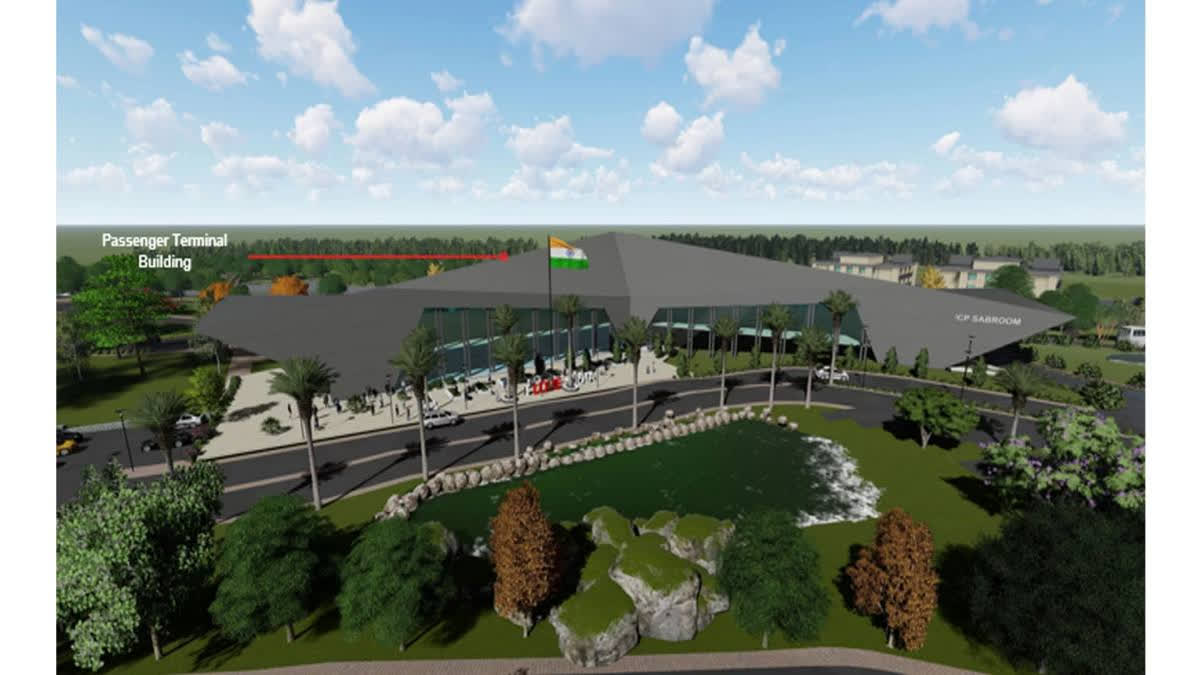New Delhi: Among the slew of projects that Prime Minister Narendra Modi dedicated to the nation during his visit to the Northeast this week is the Sabroom Land Port in Tripura. With the opening of the Sabroom Land Port, India’s northeastern region will get direct access to the Chittagong Port in Bangladesh, which is just 75 km away compared to the Kolkata/Haldia Port, which is 1,700 km away. Through the Chittagong Port, maritime connectivity will be established between northeastern India and Southeast Asia via the Bay of Bengal.
Modi laid the foundation stone of the Sabroom Land Port in March 2021. The land port is located in the South Tripura district of the state of Tripura along the international border between India and Bangladesh. It is strategically located at the southernmost tip of Tripura and will play a vital role in linking India and Bangladesh, both through road and railway links.
Built at a cost of Rs 230 crore, the Sabroom Land Port is directly connected to Chittagong port of Bangladesh through the Maitree Setu (Friendship Bridge) over River Feni. With this, Tripura will become a gateway to India’s northeastern region. The new land port will also connect to the Matarbari deep sea port in Bangladesh which is under construction with Japanese aid. With the opening of this land port, apart from India’s northeastern region, other landlocked countries in the region like Bhutan and Nepal will now get access to the Bay of Bengal.
During the virtual inauguration of the land port by Prime Minister Modi from Itanagar on Saturday, Tripura Chief Minister Manik Saha expressed enthusiasm about the opening of this port and the Maitree Setu. He stated that these developments will usher in an era of enhanced connectivity and people-to-people ties between India and Bangladesh, leading to the growth of a new shared civilisation and culture. Saha highlighted that Bangladesh’s granting of access to the Chittagong port will greatly benefit both nations through increased trade and commercial activities. Furthermore, he emphasised that Tripura will now emerge as a crucial link between Southeast Asia, Bangladesh, and India, particularly the northeastern region, due to its strategic location.
The Sabroom Land Port will provide facilities like the passenger terminal building, cargo administrative building, warehouse, fire station building, electrical substation and pump house. It will facilitate the movement of passengers and cargo between India and Bangladesh as through the new port one can move directly to Chittagong port of Bangladesh, which is only two-and-a-half hours away by road.
The Sabroom Land Port is the fourth such along the India-Bangladesh border, the others being at Agartala in Tripura, Dawki in Meghalaya and Petrapole in West Bengal. The Sabroom Land Port and Maitree Setu are among several projects to boost connectivity in the Northeast and neighbouring countries, including Myanmar and Bangladesh in the face of Chinese influence in the region.
Beijing has already gained a backdoor entry to the Indian Ocean by investing in the Kyaukpyu port in Myanmar’s Rakhine state. Other Chinese infrastructure projects in the region under Chinese President Xi Jinping’s Belt and Road Initiative (BRI) include the construction of the Hambantota port in Sri Lanka and the building of an airport in the tourist city of Pokhara in Nepal.
In May last year, the Sittwe port, also in the Rakhine state of Myanmar, which was constructed by India was inaugurated. The port connects with Mizoram in northeastern India via the Kaladan Multimodal Transit Transport Corridor. However, the progress of work on this project has considerably slowed down because of the ongoing conflict between the Myanmar resistance forces and the military junta. This is why the opening of the Sabroom Land Port in Tripura assumes additional importance.
The Kaladan Multimodal Transport Corridor is not confined to connecting Mizoram to Myanmar, but it also encompasses India’s expanded outreach to the prosperous Southeast Asian economies. Additionally, India, being a member of the Bay of Bengal Initiative for Multi-Sectoral Technical and Economic Cooperation (BIMSTEC), the new connectivity routes would help India deepen its presence and ties with the prosperous Southeast Asian countries.
Access to the Bay of Bengal will also substantially bring down freight transportation costs to the Northeast. As of now, the only option for freight transportation between the Northeast and the rest of India is through the Siliguri Corridor, popularly known as the Chicken’s Neck. With the chain of ports along India’s eastern coast, Indian naval ships can now freely ply in the Bay of Bengal, which is at the centre of the Indo-Pacific region. This will help deter the presence of Chinese naval ships in these waters.
In terms of land connectivity, India is also constructing the India-Myanmar-Thailand Trilateral Highway. The Highway connects Moreh in Manipur with Mae Sot in Thailand via Mandalay, Naypyitaw and Bago in Myanmar. In terms of sub-regional connectivity, India is a party to the Bangladesh-Bhutan-India-Nepal (BBIN) Motor Vehicle Agreement (MVA). The Agreement was conceived after the South Asian Association for Regional Cooperation (SAARC) failed to agree on a regional motor vehicles agreement at a summit in Nepal in 2014, mainly because of opposition from Pakistan. India, Bangladesh and Nepal have signed the agreement. Bhutan, which had temporarily opted out pending parliamentary approval, is now actively mulling joining the MVA, according to reports. Bhutan said this during a meeting on the implementation of the BBIN MVA held in Dhaka, Bangladesh, earlier this week.
Read more: Explained: How Northeast Is Emerging As An Important Player In India’s Paradiplomacy



